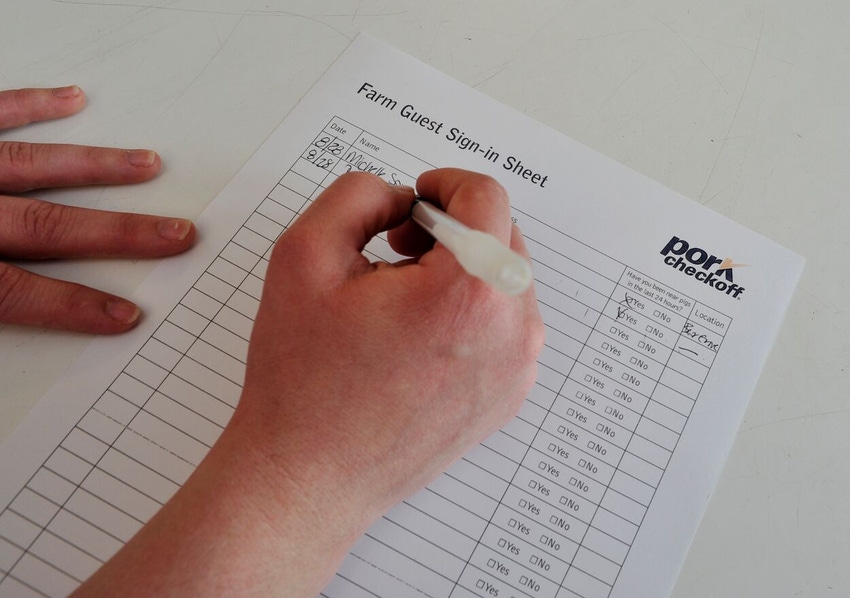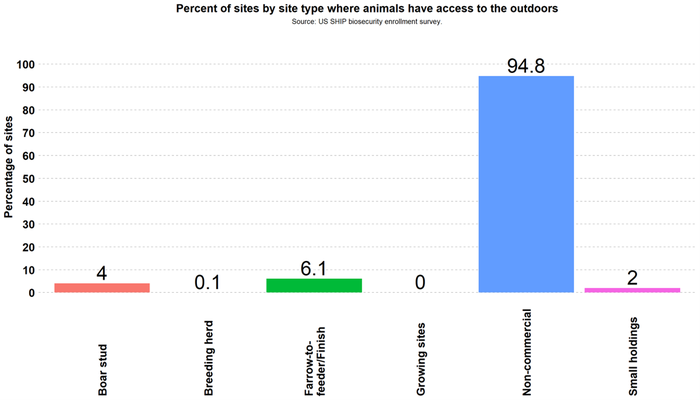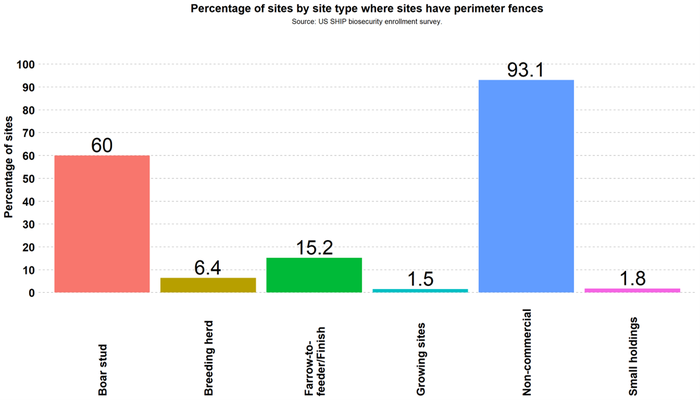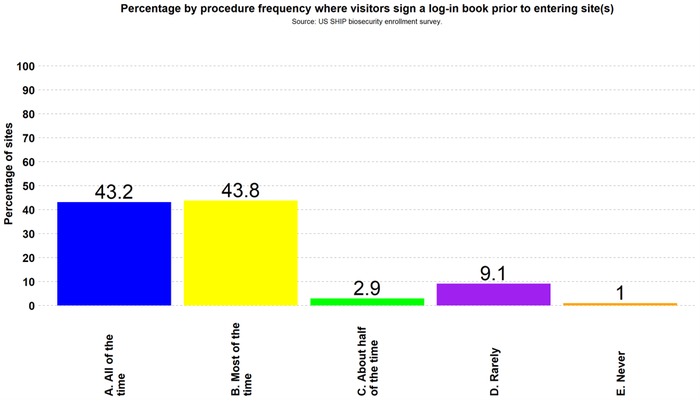The act of tracking who is on your site and when is vital to responding to an outbreak.
April 12, 2023

In a previous article we discussed the U.S. Swine Health Improvement Plan and its efforts to establish a "national playbook" of technical standards associated with biosecurity, traceability and sampling/testing which can be used for foreign animal diseases preparedness and prevention. That article can be found here.
US SHIP is a collaborative effort between industry, state and federal entities modeled after the National Poultry Improvement Plan, but is specifically organized to meet the unique needs and challenges of the U.S. swine industry. In an effort to understand the current status of biosecurity practices being implemented in the U.S. swine industry, all producers enrolling sites with US SHIP are asked to complete a biosecurity survey. As of January 2023, 7,902 individual sites (6,784 growing pig, 849 breeding herd, 110 small holding, 58 non-commercial, 50 boar stud, 33 farrow-to-feeder/finish, and 18 packing plants) in 31 states have responded to the survey. This represents 52% of the U.S. breeding herd and 44% of the U.S. growing pig herd inventory.
Outdoor access
Once FADs like African swine fever virus and classical swine fever virus are introduced to an area, they can be maintained in reservoirs. Wild boar populations are one example of a reservoir. Once in the wild boar population, eradicating ASF and CSF gets extremely difficult.
Many swine FADs are transmissible through contact and some can be transmitted through tick vectors. There are three species of soft tick, Ornithodoros coriaceus, Ornithodoros turicata and Ornithodoros puertoricensis that are present in the Western United States and are thought to be able to transmit the ASF virus.
The US SHIP biosecurity working group is evaluating what mitigation strategies should be implemented in indoor and outdoor pigs to help decrease the risk posed by feral pigs and tick vectors in FAD transmission. Having measures in place before any FAD introduction could help decrease risks.
The US SHIP enrollment biosecurity survey asked if animals had access to the outdoors. Most sites do not allow access to the outdoors. Sites self-identified as non-commercial are the exception with 94.8% of respondents allowing access to the outdoors (Figure 1). Non-commercial sites are a significant part of the U.S. swine industry. Increasing representation and involvement of non-commercial, small holdings, cull market and other swine industry partners in US SHIP helps to ensure the standards set forth in the "national playbook" are balanced for all industry stakeholders.

Perimeter fencing
While limiting outdoor access is ideal, the implementation of perimeter fencing can help reduce the possibility of contact with the wild boar population. Swine are notoriously challenging to exclude via perimeter fencing, thus making the design and construction of the fencing important to overall effectiveness.
Fencing recommendations from the University of Tennessee and Penn State University recommend a height between 40-54 inches an electrified or barbed wire strand at the base to prevent rooting. Bottom wires should also be between 1.5 to 2 inches apart to prevent piglets from getting their heads through. 1, 2
The survey shows 93.1% of non-commercial respondents have perimeter fencing, (Figure 2), which helps mitigate risk of outdoor access. Overall, 60% (30 of 50) of the boar stud sites responded they have perimeter fencing. This survey did not ascertain the quality of the fencing, only its presence.
1Buschermohle, M., Wills, J., Gill, W., & Lane, C. (n.d.). Planning & Building Fences on the Farm. The University of Tennessee Institute of Agriculture.
2What Type of Fence Will I Need to Pasture Hogs? (Swine Home Study Course). (n.d.). Swine Home Study Course (Penn State College of Ag Sciences).

Visitor log books
Understanding who is on the site and when they were there is essential to tracing the possible disease spread during an outbreak investigation. Epidemiologists can use visitor log books to trace back human contacts to find potential links of where an outbreak could have started. With this information, they can identify and address the issues that allowed the entrance of the pathogen in the site. Authorities can use this information to trace forward and focus resources where the disease spreaders might have been but no disease has been detected.

The survey indicates that 43.2% of responding sites require every visitor to sign in, every time. Breeding herd sites were the strictest with 91.5% of sites requiring visitors to sign a visitor entry log book every time. Every respondent site type had at least one response of never. The act of tracking who is on your site and when is vital to responding to an outbreak.3,4 Both the Secure Pork Supply and the Pork Quality Assurance Plus recommend entry logs as part of site biosecurity plan. The next article will discuss how US SHIP works with and incorporates SPS and PQA Plus.
US SHIP is working hard to prevent and prepare for FADs such as ASF. We need you. US SHIP works through partnerships with industry and government. To find out how you can participate and help protect the swine industry, visit the project website and talk with your official state agency. A list of OSA contact can be found on the US SHIP website.
1Self-Assessment Checklist for Enhanced Pork Production Biosecurity: Animals Raised Indoors. (2017, August). Secure Pork Supply. Retrieved March 30, 2023.
2PQA Plus Version 5.0. (2022). Pork Checkoff.
You May Also Like



